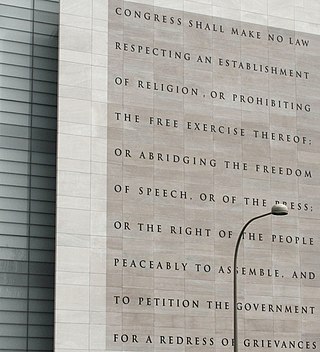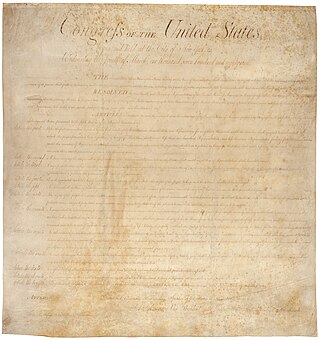Related Research Articles

The First Amendment to the United States Constitution prevents the government from making laws that regulate an establishment of religion, or that prohibit the free exercise of religion, or abridge the freedom of speech, the freedom of the press, the freedom of assembly, or the right to petition the government for redress of grievances. It was adopted on December 15, 1791, as one of the ten amendments that constitute the Bill of Rights.
Corporate personhood or juridical personality is the legal notion that a juridical person such as a corporation, separately from its associated human beings, has at least some of the legal rights and responsibilities enjoyed by natural persons. In most countries, a corporation has the same rights as a natural person to hold property, enter into contracts, and to sue or be sued.
R.A.V. v. City of St. Paul, 505 U.S. 377 (1992), is a case of the United States Supreme Court that unanimously struck down St. Paul's Bias-Motivated Crime Ordinance and reversed the conviction of a teenager, referred to in court documents only as R.A.V., for burning a cross on the lawn of an African-American family since the ordinance was held to violate the First Amendment's protection of freedom of speech.

In the United States, freedom of speech and expression is strongly protected from government restrictions by the First Amendment to the U.S. Constitution, many state constitutions, and state and federal laws. Freedom of speech, also called free speech, means the free and public expression of opinions without censorship, interference and restraint by the government. The term "freedom of speech" embedded in the First Amendment encompasses the decision what to say as well as what not to say. The Supreme Court of the United States has recognized several categories of speech that are given lesser or no protection by the First Amendment and has recognized that governments may enact reasonable time, place, or manner restrictions on speech. The First Amendment's constitutional right of free speech, which is applicable to state and local governments under the incorporation doctrine, prevents only government restrictions on speech, not restrictions imposed by private individuals or businesses unless they are acting on behalf of the government. However, It can be restricted by time, place and manner in limited circumstances. Some laws may restrict the ability of private businesses and individuals from restricting the speech of others, such as employment laws that restrict employers' ability to prevent employees from disclosing their salary to coworkers or attempting to organize a labor union.
First National Bank of Boston v. Bellotti, 435 U.S. 765 (1978), is a U.S. constitutional law case which defined the free speech right of corporations for the first time. The United States Supreme Court held that corporations have a First Amendment right to make contributions to ballot initiative campaigns. The ruling came in response to a Massachusetts law that prohibited corporate donations in ballot initiatives unless the corporation's interests were directly involved.
In United States constitutional law, a state actor is a person who is acting on behalf of a governmental body, and is therefore subject to limitations imposed on government by the United States Constitution, including the First, Fifth, and Fourteenth Amendments, which prohibit the federal and state governments from violating certain rights and freedoms.
Rust v. Sullivan, 500 U.S. 173 (1991), was a case in the United States Supreme Court that upheld Department of Health and Human Services regulations prohibiting employees in federally funded family-planning facilities from counseling a patient on abortion. The department had removed all family planning programs that involving abortions. Physicians and clinics challenged this decision within the Supreme Court, arguing that the First Amendment was violated due to the implementation of this new policy. The Supreme Court, by a 5–4 verdict, allowed the regulation to go into effect, holding that the regulation was a reasonable interpretation of the Public Health Service Act, and that the First Amendment is not violated when the government merely chooses to "fund one activity to the exclusion of another."
In United States constitutional law, a forum is a property that is open to public expression and assembly.
Rosenberger v. Rector and Visitors of the University of Virginia, 515 U.S. 819 (1995), was an opinion by the Supreme Court of the United States regarding whether a state university might, consistent with the First Amendment, withhold from student religious publications funding provided to similar secular student publications. The University of Virginia provided funding to every student organization that met funding-eligibility criteria, which Wide Awake, the student religious publication, fulfilled. The university's defense claimed that denying student activity funding of the religious magazine was necessary to avoid the University's violating the Establishment Clause of the First Amendment.
Morse v. Frederick, 551 U.S. 393 (2007), is a United States Supreme Court case where the Court held, 5–4, that the First Amendment does not prevent educators from suppressing student speech that is reasonably viewed as promoting illegal drug use at or across the street from a school-supervised event. In 2002, Juneau-Douglas High School principal Deborah Morse suspended student Joseph Frederick after he displayed a banner reading "BONG HiTS 4 JESUS" [sic] across the street from the school during the 2002 Winter Olympics torch relay. Frederick sued, claiming his constitutional rights to free speech were violated. His suit was dismissed by the federal district court, but on appeal, the Ninth Circuit reversed the ruling, concluding that Frederick's speech rights were violated. The case then went on to the Supreme Court.
Pruneyard Shopping Center v. Robins, 447 U.S. 74 (1980), was a U.S. Supreme Court decision issued on June 9, 1980 which affirmed the decision of the California Supreme Court in a case that arose out of a free speech dispute between the Pruneyard Shopping Center in Campbell, California, and several local high school students.
Board of Regents of the University of Wisconsin System v. Southworth, 529 U.S. 217 (2000), is a ruling by the Supreme Court of the United States which held that public universities may subsidize campus groups by means of a mandatory student activity fee without violating the students' First Amendment rights.

William Hubbs Rehnquist was an American attorney and jurist who served on the U.S. Supreme Court for 33 years, first as an associate justice from 1972 to 1986 and then as the 16th chief justice from 1986 until his death in 2005. Considered a staunch conservative, Rehnquist favored a conception of federalism that emphasized the Tenth Amendment's reservation of powers to the states. Under this view of federalism, the Court, for the first time since the 1930s, struck down an act of Congress as exceeding its power under the Commerce Clause.
Legal Services Corp. v. Velazquez, 531 U.S. 533 (2001), is a decision of the Supreme Court of the United States concerning the constitutionality of funding restrictions imposed by the United States Congress. At issue were restrictions on the Legal Services Corporation (LSC), a private, nonprofit corporation established by Congress. The restrictions prohibited LSC attorneys from representing clients attempting to amend existing welfare law. The case was brought by Carmen Velazquez, whose LSC-funded attorneys sought to challenge existing welfare provisions since they believed that it was the only way to get Velazquez financial relief.
National Endowment for the Arts v. Finley, 524 U.S. 569 (1998), was a United States Supreme Court case in which the Court ruled that the National Foundation on the Arts and Humanities Act, as amended in 1990,, was facially valid, as it neither inherently interfered with First Amendment rights nor violated constitutional vagueness principles. The act in question required the Chairperson of the National Endowment for the Arts (NEA) to ensure that "artistic excellence and artistic merit are the criteria by which [grant] applications are judged, taking into consideration general standards of decency and respect for the diverse beliefs and values of the American public". Justice O'Connor delivered the opinion of the Court.

In the United States, some categories of speech are not protected by the First Amendment. According to the Supreme Court of the United States, the U.S. Constitution protects free speech while allowing limitations on certain categories of speech.
Madsen v. Women's Health Center, Inc., 512 U.S. 753 (1994), is a United States Supreme Court case where Petitioners challenged the constitutionality of an injunction entered by a Florida state court which prohibits antiabortion protesters from demonstrating in certain places, and in various ways outside of a health clinic that performs abortions.
Viewpoint discrimination is a concept in United States jurisprudence related to the First Amendment to the United States Constitution. If a speech act is treated differently by a government entity based on the viewpoint it expresses, this is considered viewpoint discrimination.
Heffernan v. City of Paterson, 578 U.S. ___ (2016), was a United States Supreme Court case in 2016 concerning the First Amendment rights of public employees. By a 6–2 margin, the Court held that a public employee's constitutional rights might be violated when an employer, believing that the employee was engaging in what would be protected speech, disciplines them because of that belief, even if the employee did not exercise such a constitutional right.
Hate speech in the United States cannot be directly regulated by the government due to the fundamental right to freedom of speech protected by the Constitution. While "hate speech" is not a legal term in the United States, the U.S. Supreme Court has repeatedly ruled that most of what would qualify as hate speech in other western countries is legally protected free speech under the First Amendment. In a Supreme Court case on the issue, Matal v. Tam (2017), the justices unanimously reaffirmed that there is effectively no "hate speech" exception to the free speech rights protected by the First Amendment and that the U.S. government may not discriminate against speech on the basis of the speaker's viewpoint.
References
- 1 2 3 Hudson, David. The Rehnquist Court: Understanding Its Impact and Legacy , p. 91 (Greenwood Publishing 2007).
- 1 2 3 Fagundes, David (2006). "State Actors as First Amendment Speakers". Northwestern University Law Review. 100 (4): 1637–88.
- ↑ Volokh, Eugene. "Do state and local governments have free speech rights?", Volokh Conspiracy (June 24, 2015).
- ↑ Rust v. Sullivan, 500 U.S. 173 (1991). See also Rosenberger v. Rector and Visitors of the University of Virginia, 515 U.S. 819 (1995), as well as Johanns v. Livestock Marketing Association , 544 U.S. 550 (2005).
- ↑ Puiszis, Steven. Illinois Governmental Tort and Section 1983 Civil Rights Liability , p. 837 (Matthew Bender, Third Edition, 2012).
- ↑ Nowak, John and Rotunda, Ronald. Nowak and Rotunda's Principles of Constitutional Law , p. 919 (West Academic, 2010).